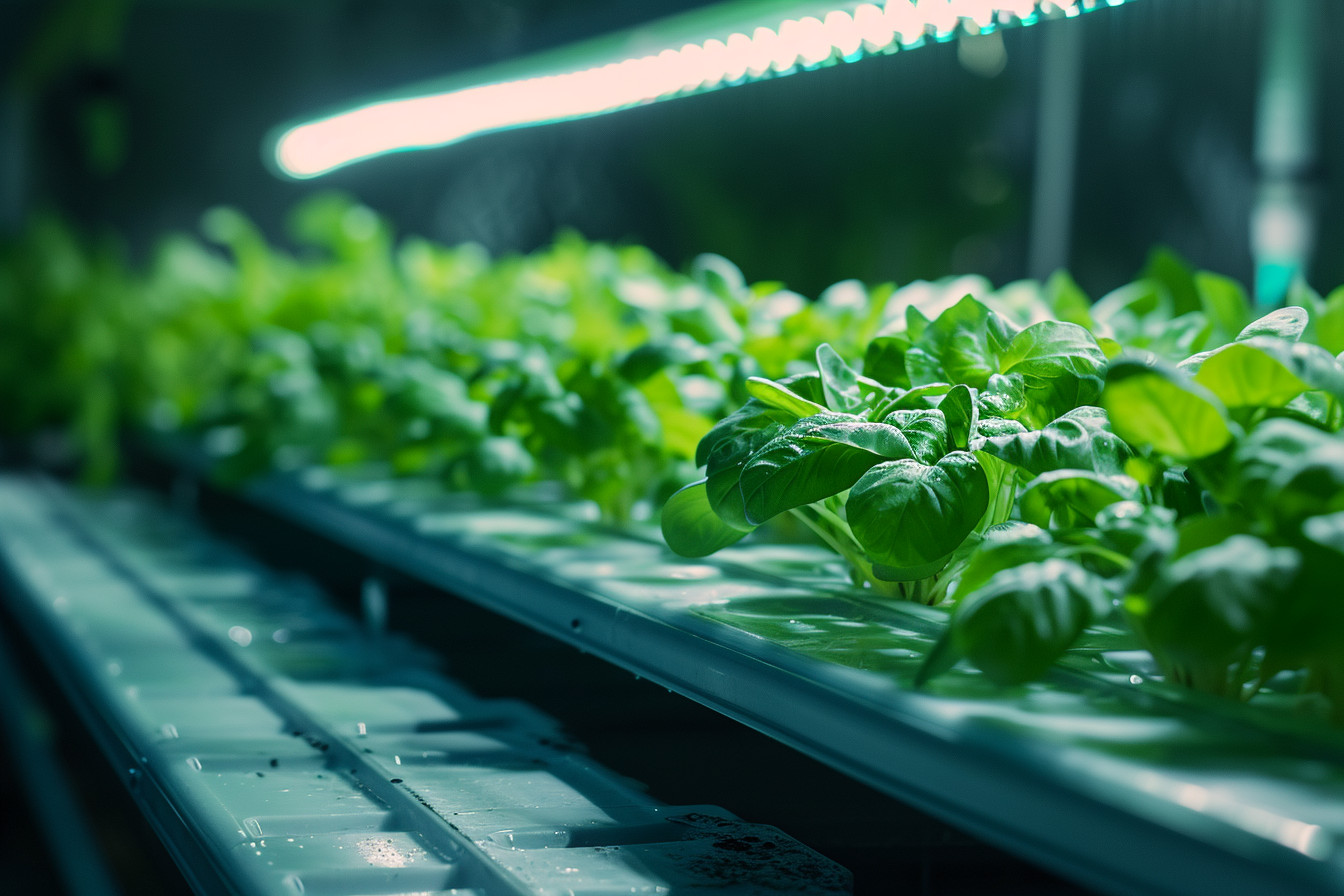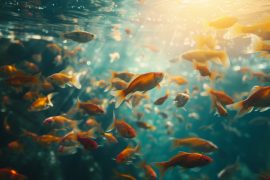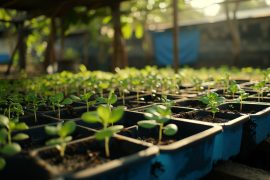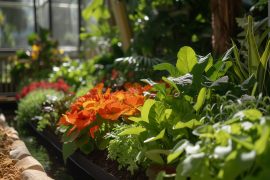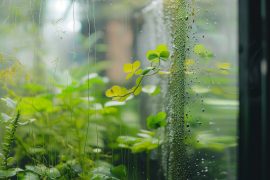Imagine stepping into a garden where the tranquility of growing plants meets the gentle swirl of fish beneath the water’s surface. That’s the serene world of aquaponics, a space where harmony and sustainability aren’t just ideals—they’re the very foundation.
I’ve always been fascinated by how we can push the boundaries of traditional farming, and aquaponics does just that. It’s a game-changer in the way we think about producing food. By marrying aquaculture with hydroponics, this innovative system can potentially transform our food landscape, making it more efficient and eco-friendly.
As a gardening enthusiast, I’m thrilled to dive into the nuts and bolts of aquaponics, sharing insights on how it could shape our future meals. It’s not just about growing food; it’s about cultivating a sustainable and peaceful relationship with our environment. Let’s explore this incredible synergy of fish and plants and see how it might just revolutionize our world.
The Concept of Aquaponics
I’m continually amazed by the simplicity and elegance of aquaponics. At its heart, it’s a blend of two established methods: aquaculture, where fish are raised in tanks, and hydroponics, a method of growing plants without soil. Seen through a contemplative lens, aquaponics mirrors the harmonious give-and-take found in natural ecosystems.
The tranquility that governs my gardening space seems to resonate with the principles of aquaponics. It’s a vivid dance of life, where fish and plants thrive together. I find a profound sense of peace in the circulating water, a reminder of the seamless flow of energy and nutrients between species – a tranquil concerto of sustainability.
To share the nuts and bolts of aquaponics, let’s break it down. Fish produce waste, mostly in the form of ammonia. In a typical garden, waste isn’t exactly our friend, but in an aquaponic system, it’s pure gold. Beneficial bacteria convert this ammonia into nitrates, which, in layman’s terms, are like a superfood for plants. On the flip side, the plants act as a natural filtration system, cleaning the water that cycles back to the fish. It’s a perfect example of a closed-loop system – nothing is wasted, and everything is valued.
I’ve seen enough case studies and had my own hands in the water to say it’s way more than a farming technique. It’s a paradigm shift in how we view our relationship with food and nature. Take the story of a school in my city that transformed an old parking lot into a thriving aquaponic setup. Kids who used to speed past on their skateboards now marvel at the tilapia and leafy greens that have taken over the concrete. They learn life skills, sure, but they also get a firsthand glimpse of sustainable practices that could steer their future.
When you dive deeper into the historical context, you’ll find that although the term “aquaponics” may sound modern, the concept is ancient. There’s evidence of Aztec cultures employing rudimentary forms of aquaponics centuries ago. It’s not only an educational journey through the timeline of agriculture but also a testament to human ingenuity and our connection to the cycles of nature.
How Aquaponics Works
Imagine a garden that’s alive with the gentle sound of water and the sight of fish gracefully swimming. This peaceful image, believe it or not, is the essence of a robust food production system known as aquaponics. In my journey through sustainable farming, I’ve come to see aquaponics not just as a method to grow food, but as a way to reconnect with nature’s subtle dances.
Aquaponics combines the best of two worlds: aquaculture and hydroponics. Aquaculture is the practice of raising fish or other aquatic animals, while hydroponics involves growing plants without soil. It’s like creating a miniature ecosystem right in your backyard. I find a certain Zen in watching each element work in harmony with the others.
Here’s the rundown on how it all comes together:
- Fish produce waste:
Fish need to eat. As they consume their meals, they naturally produce waste. In a traditional setup, this waste becomes a problem. But here’s where the magic happens in aquaponics – it transforms a potential problem into a powerful resource. - Bacteria do their thing:
There’s a special kind of bacteria that thrives in the aquaponic environment. They’re the unsung heroes, converting ammonia from the fish waste into nitrates. Nitrates are a form of nitrogen that plants crave. Just think of them as the middlemen, making sure everyone’s happy. - Plants get fed:
Those nutrients? They get pumped up to the plants. Roots dangle in the water, sipping on the nitrate-rich cocktail, and in return, the plants grow robust and full of life without any chemical fertilizers. It’s what I’d call the ultimate organic experience. - Water gets cleaned and recirculated:
Finally, the same water that nourished the plants gets filtered and sent back to the fish. It’s now cleaner and ready for another round. Each time I watch the water cycle through, I’m reminded of the Earth’s natural cycles. It’s like having a piece of the planet’s essence right in your very own garden.
Benefits of Aquaponics
As I dig deeper into the world of aquaponics, it’s impossible not to get excited about its numerous benefits. There’s a real sense of harmony here—I often find myself captivated by the peaceful coexistence of fish and plants. It’s like having a slice of the natural world, a tranquil garden right at home. Plus, imagine the bonus of growing your own food, which can be both a wellness practice and a step towards sustainability.
Reduced Water Usage stands out as one of aquaponics’ big wins. It’s remarkable really; this system uses about 90% less water than traditional soil farming. I remember stumbling upon this fact and feeling astounded. It’s transformative for areas facing water scarcity. Instead of constant watering, you’re recycling water within the system, which is both ingenious and cost-effective.
Then there’s the Elimination of Chemical Fertilizers. In an aquaponics setup, the fish effectively provide the nutrients through their waste. This eliminates the need for synthetic inputs, making it a fully organic process. For someone like me, who gets a bit queasy at the thought of chemicals on my lettuce, aquaponics offers a breath of fresh air.
Let me give you a snapshot of the Space Efficiency. Whether you live in the city with just a balcony or have a small backyard, aquaponics doesn’t discriminate. It can scale from small to large setups without compromising on productivity. Have you ever seen a vertical aquaponics garden? They are not just space-savers but also living green sculptures—functional and beautiful.
Now when it comes to Growth Speed and Yield, it’s pretty impressive. Plants in an aquaponic system have constant access to nutrients, so they grow faster. I’ve seen figures suggesting that growth rates can potentially double. Here’s a quick look at the difference in productivity between conventional farming and aquaponics:
| Plant Type | Conventional Farming Yield | Aquaponics Yield |
|---|---|---|
| Lettuce | 3-4 weeks | 2 weeks |
| Spinach | 5-6 weeks | 3 weeks |
| Bell Peppers | 90-150 days | 60-90 days |
| Cherry Tomatoes | 50-75 days | 40-60 days |
The Environmental Impact of Aquaponics
As we dive deeper into the world of aquaponics, I’m often struck by its serene dance with the environment. There’s a palpable sense of harmony that comes through in this sustainable food production system. Perhaps it’s the seamless way fish and plants support one another, or maybe it’s the minimal footprint it leaves on our precious earth. It’s clear to me that aquaponics isn’t just a method to grow food; it’s a symbol of balance and a testament to what we can achieve when we align our practices with nature’s rhythms.
Educationally speaking, aquaponics is a living classroom of symbiosis. Fish waste provides an organic nutrient source for the plants, while the plants clean and filter the water, which is then recirculated back to the fish tanks. This cycle mimics natural ecosystems, and it’s incredible to watch. The nitrifying bacteria play a crucial, often underappreciated role, converting ammonia from fish waste into nitrates that plants can uptake as food. Here are some impressive numbers that highlight this synergistic relationship in aquaponic systems:
| Factor | Aquaponics Efficiency |
|---|---|
| Water Usage | Up to 90% Less than Soil Farming |
| Growth Speed | Faster Access to Nutrients |
| Chemical Fertilizer | Elimination of Synthetic Inputs |
| Space Efficiency | High Yields in Smaller Footprints |
Let’s break this down. Reduced water usage is a massive win for the environment. In a world where water scarcity is becoming a difficult reality, using less to grow more is a principle we ought to live by. The absence of chemical fertilizers not only protects our waterways from harmful runoff but also supports a more organic, healthier food production process.
On the technical side, aquaponics is all about efficiency. Space isn’t a luxury everyone has, yet this method allows for vertical stacking of plants, maximizing yields in tight quarters. Even urban dwellers can join the farming game, turning rooftops into lush gardens. And faster growth speeds? That means we can have more harvests per year compared to traditional soil-based methods. It’s a food security game-changer.
Aquaponics in Action: Success Stories
As a gardening enthusiast and a strong proponent of sustainable practices, I’ve witnessed firsthand the transformative power of aquaponics. Let me take you through a few inspiring examples that’ll really show the potential of this system.
In the heart of Milwaukee, there’s a facility that was once a deserted industrial building but now it’s an aquaponic haven known as Growing Power. This place isn’t just a farm; it’s a testament to the power of human and nature collaboration. They’ve been paving the way in urban agriculture by producing tons of fresh produce and fish annually. The amalgamation of tilapia and a variety of greens creates not just food but an ecosystem that mimics the tranquility of nature in the urban sprawl. It’s a learning center too, educating young and old about the blissful simplicity of growing your own food.
Down south, Green Acre Aquaponics in Florida is another story brimming with success. The founders turned their passion for home gardening into a full-fledged operation that provides fresh food to their community and local restaurants. Their model is so efficient and easy to grasp that they’ve started teaching others how to set up their own systems. They advocate that you don’t have to be a gardening guru or tech whizz to get your hands dirty and be successful with aquaponics.
Switching coasts to California, I’ve also been inspired by the Sweet Water Foundation. Their aquaponics system intertwines with community development, emphasizing not just food production but also the importance of creating peaceful, green spaces in urban environments. It’s fascinating to see fish tanks and plant beds nestled between buildings, offering passersby a moment of serenity amidst their daily hustle.
Out of my own backyard, I’ve seen neighbors transform their small garden spaces into bountiful aquaponic arenas. It isn’t complex wizardry but rather, a harmony of water, life, and a bit of know-how. Schools are catching on, integrating these systems into their science curriculum. It’s more than a lesson in biology; it’s a lesson in stewardship and sustainability.
| Location | Benefits Achieved |
|---|---|
| Growing Power | Produced tons of food annually using a closed-loop system |
| Green Acre Aquaponics | Education center for the community |
Final Thought
I’ve gotta say, aquaponics is more than just a trend—it’s a glimpse into a future where we can grow food in harmony with nature. It’s not just about what we eat; it’s about rethinking our relationship with the environment. I’m genuinely excited to see how aquaponics will continue to evolve and maybe even revolutionize our food systems. It’s clear that this isn’t just a fad, but a sustainable approach with the potential to bring communities together, educate our kids, and maybe, just maybe, make our world a little greener. Here’s to hoping we see more of these systems sprouting up in neighborhoods everywhere, bringing fresh, local produce to our tables and lessons in sustainability to our lives.
